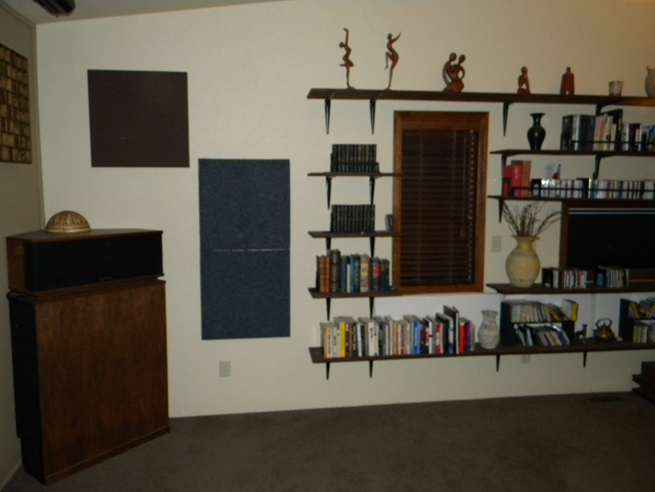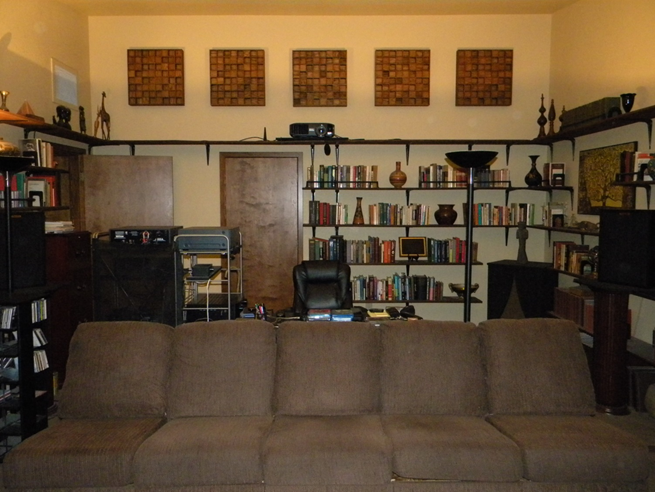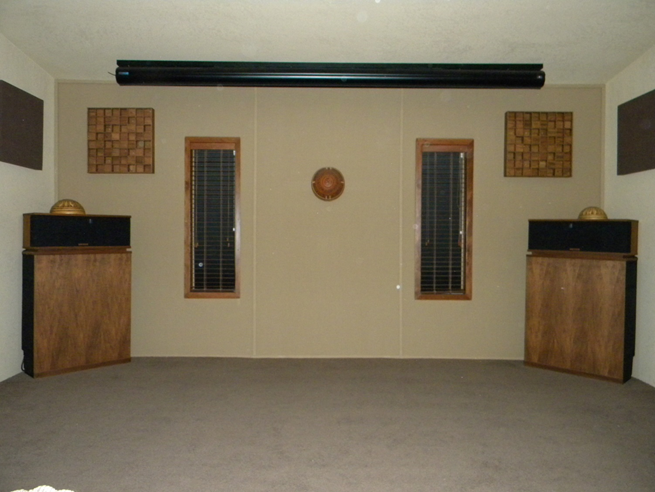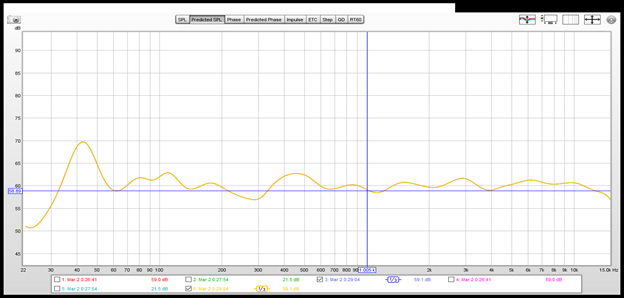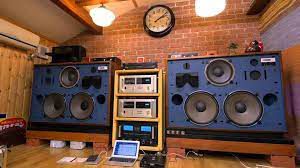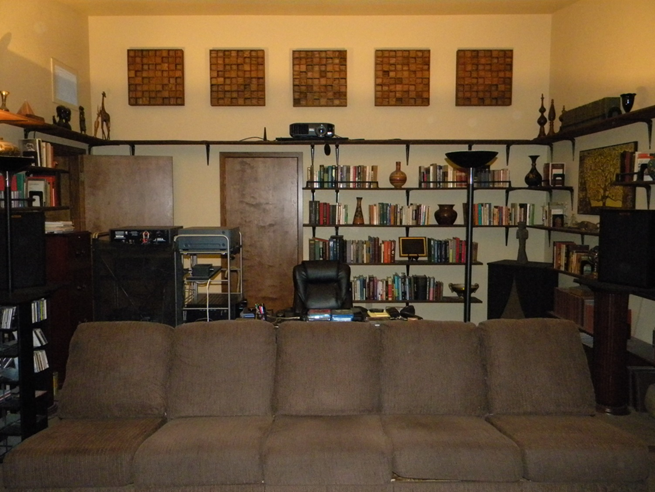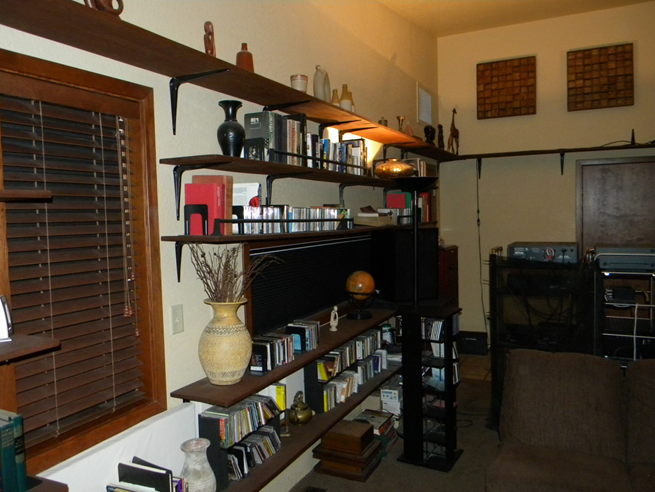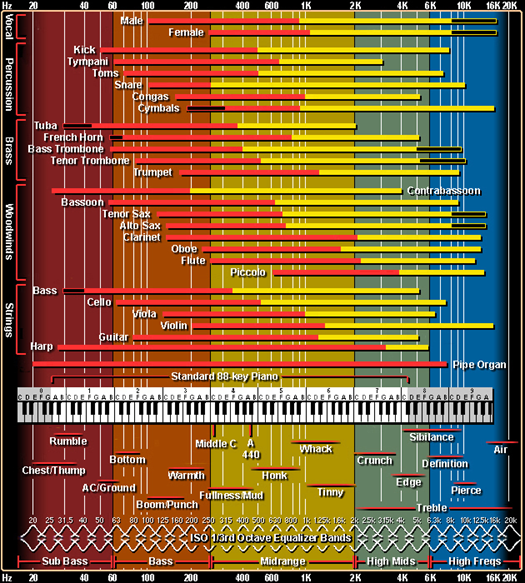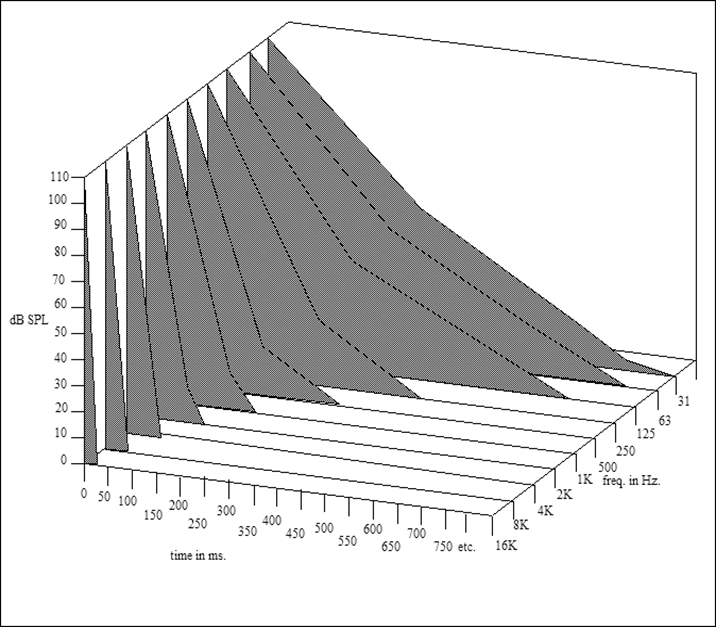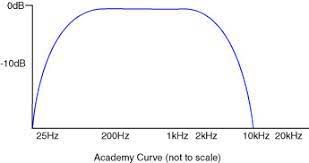-
Posts
4186 -
Joined
-
Last visited
Content Type
Forums
Events
Gallery
Everything posted by garyrc
-
At one point, JBL said that some damping factors were too high for some of their speakers. This was in the 1960s, perhaps the 1970s. It could have been in an article by George Augspurger. Or not.
-
I think one Klipsch engineer, IIRC, said that a 1/2 hour break-in/burn-in time would be appropriate for woofers. I could be wrong, but I'm confident it was a short time. OTOH, when we upgraded our Klipschorns to AK4 (from AA), mounted the K77F tweeters flush with the front of the baffle board (using the bracket supplied by Klipsch), replaced the K400 mid-horns with K401s, and changed to the new (then) AK4 crossover networks, the sound was clearer, but not quite balanced. The AK4 upgrade did not require a change in the woofer -- they stuck with the K 33E, which is still in the Cornwall IVs and the Klipschorn AK6, as well. After about (??? 50 hours of burn-in ???) it sounded distinctly better. I know this could be merely psychological adaptation, but like so many who have noticed a change after burn-in, I don't think so. They were later improved by adding a subwoofer coming in at 60 Hz, room treatments (both absorption and diffusion), using painstakingly adjusted Audyssey, then adding approximately 6 dB boost to the sub. Finally, after adding a center channel (NAD 150 watt power amp and Belle Klipsch), we have the best sound we have ever had, soft or loud.
-
Placing Acoustic Panels For Speakers Firing From Room Corners
garyrc replied to ka7niq's topic in 2-Channel Home Audio
The curved 1/2 round cylinders may be Dr. Bonner's solution which were advocated by PWK. Artto had or has a room full of them in Artto's Klipschorn room, on the forum. He has different speakers now. He and Chris A are two of the most knowledgeable people on the forum (IMO). I used absorption near the speakers, and diffusers farther away from both the listeners and the speakers. After a little careful EQ, the room sounds great! To see Artto's room, try: https://community.klipsch.com/index.php?/topic/19799-arttos-klipschorn-room/ -
Placing Acoustic Panels For Speakers Firing From Room Corners
garyrc replied to ka7niq's topic in 2-Channel Home Audio
-
Placing Acoustic Panels For Speakers Firing From Room Corners
garyrc replied to ka7niq's topic in 2-Channel Home Audio
@ka7niq See Chris A's articles on this, here on the community forum, specifically addressing absorption panels in rooms with corner horns. https://community.klipsch.com/index.php?/topic/131163-corner-horn-imaging-faq/ Here is an excerpt from Chris's posts; see my final 2 cents at the bottom of the page. "These early reflections should be controlled (i.e., a "Zero Reflection Zone" that one acoustic panel manufacturer uses) in order to achieve much greater imaging performance with speakers in corners of rooms (especially corner horns). What is the easiest way to control these reflections? Have a smooth boundary between the speakers (i.e., nothing between the speakers) and smooth front and side walls. If this is not possible for your room and setup, the next easiest fix is to employ absorption panels. Many companies make "fuzz" panels and tiles that can easily be placed along side walls and front walls of the your listening room. How much? It turns out (from the Haas Effect) that controlling the early reflections should be done for about 10-20 milliseconds of delayed reflections from side and front walls. This translates into about 11 to 22 feet (3.4-6.8 meters) of total path length at room temperature. One way to determine how much absorption you need about the midrange horn mouth area on the front and side walls is to draw a plan view of your room (i.e., looking down on the floor plan), and draw circles from your listening position in increments of 12, 14, 16, 18, and 20 feet (4.9, 5.5, 6.1 meters). Then draw circles of 2, 4, 6, 8, etc. feet (0.6, 1.2, 1.8, etc. meters) from your midrange horn mouth locations in-room. Where the circles intersect along the walls with total path length of less than 11-22 feet (3.4-6.8 meters), mark those areas with a highlighter, then go open a bottle of wine with your spouse. Wait until the wine takes effect, then start the negotiations on how much absorbent tiles/panels are acceptable (...hopefully, the answer isn't "zero"...). I use about 2 feet (0.6 meters) of absorption at the side-wall exit area of my corner-horn midrange horns: YMMV. Depending on your room geometry and listening position in relation to the corner horn placement (i.e., the included angle of the speakers relative to the listener--typically 90+ degrees included angle), the width of the midrange horn acoustic coverage laterally (~60-100 degrees included angle), and assuming that your corner horn midrange horn controls its polar response down to its lower crossover frequency*, the area that you should cover with absorption panels could be on the order of 2-10 feet along the front and side walls. I find that 2 feet of absorption along side walls works very well for Klipsch K-402 horns (i.e. Jubilee), and ~7 feet across the front wall, measured from the exit of each midrange horn's mouth. Another approach is to place diffuser panels along the same areas, but note that the use of diffusers in the "Hass effect areas" will likely not achieve the same level of corner-horn imaging as the use of absorbers. More on the reasons why later. If your listening position is more than 11 to 22 feet (3.4-6.8 meters) away, you probably have little work to do. If you are like me, and sit within 10 feet (3 meters) of your corner horns, you will find that the effect of using absorbent panels along the walls is spectacular in increasing your stereo imaging performance." I (Gary) like to scatter a few diffusers on more distant walls, but in the path of the speakers. Plain or fancy -
This often works for me. Actually, I try a slight bass boost first. To my ears and brain, slight edginess may be largely a matter of balance. If that doesn't work, then the treble control.
-
IMO, measuring at a considerable distance from the speakers and from just one position, even if it is the Main Listening Position, with REW is a mistake, unless, perhaps, you listen alone and keep your head in the same position during each listening session. As you know, there are modes and nulls that alter bass response, different specular and diffuse reflections and different patterns of beaming, with different treble response. See http://www.acousticfrontiers.com/wp-content/uploads/2015/03/room_mode_calc.gif Moving your head a few inches might produce considerably different results. This is the primary reason both Paul W. Klipsch and Edgar Villchur were against the use of graphic equalizers, because the ideal response in one position could result in lousy response if you moved to a slightly different one. That may be the only thing Paul and Edgar ever agreed on!😁😬 There are several ways to attempt to get around this. One is to take an average of several positions. How many? The lowest number I've heard is 3. Room correction devices often use considerably more; Audyssey uses 8, Dirac 9 to 17. Rather than a simple average, room correction often uses proprietary "fuzzy logic" (a good thing) processing. Because of this, it might be a good idea to start with one of these devices, then measure from multiple positions -- or just trust the device to provide smooth enough response.
-
I finally listened to the Haydn that Shiva posted from Youtube. It sounded excellent over our Klipschorns, violins just a tiny tad bright, cello marvelous, and somewhat "woody." The 2.5 dB bump at 450 Hz doesn't show, as far as I can tell, unless as "wood."
-
Decreased.
-
Is the center RP5000F also? If not, what? Try classical or folk (the solo female singers on the soundtrack of Amadeus, or Joan Baez, Judy Collins), or a recording you know to be good. Engineers/producers do all kind of nasty things to the female voice in pop. Try the sliders one at a time. Unfortunately, the sliders are more than 1 octave apart; better EQs have sliders 1/4 octave apart, or even closer. 63Hz 160Hz 400Hz Near "tuning A" which is 440Hz 1 KHz 2.5 KHz Possibly harsh 6.3 KHz "Presence" 16 KHz "Air" *Common usage: The term "Two Channel" is used, rather than "Stereo," because "Stereo" could mean 2, 3, 4 (theatrical CinemaScope and the like), 6 (Todd-AO and other 70mm cinema-- "'in 6 track stereo"), 7 (old Cinerama), 8 (D150). In Home Theater, a rare 2 channel film might be labeled 2, or 2.1, otherwise 5.1, 7.1, etc., etc.
-
Only that high "efficiency" (high sensitivity) "goes with" other characteristics that minimize certain kinds of distortion, such as modulation distortion. In speaker design, there are more than three desirables, but three are related, as depicted in Hoffman's Iron Law: Relatively small size Deep, good bass High efficiency Pick two; you can't have all three. For example: Small, airtight acoustic suspension speakers must have large cone excursion to produce adequate bass, which produces unwanted high modulation distortion. Because of the need for large cone excursion, these speakers are of very low efficiency. Large speakers can produce good, deep bass without much cone excursion (1/16 inch, or less, in the case of the Klipschorn, the Jubilee, and various huge speakers), so there can be very little modulation distortion. Also, since so little excursion is needed, these speakers can be very efficient. Naturally, if you have a small room and sit close to the speakers, you will need less power than with the opposite.
-
"For better sound" in what way? The ultimate test is to find the contenders and listen to them for several hours. For dealers who are willing and dedicated, this may mean allowing you to take the speakers home to listen to them in your room. They may require a deposit or other security, although I was offered the privilege of taking "anything" home from Saturday night to Monday morning (store was closed on Sundays), without putting anything down. One supposed advantage of 2 1/2 way over 2 way is sensitivity ("efficiency"). But, the RP5000F already has a sensitivity of 96 dB/2.83v (1 watt into 8 Ohms) at 1M in a "typical" living room, and probably 92 dB in an anechoic chamber. A 2 1/2 way B&W 704 that costs almost three times what your RP5000F costs, has a sensitivity of only 88 dB anechoic. Taking just the anechoic sensitivity into account, to get the same SPL you would get with a 100 watt amplifier (about 103 dB at 13 feet in a 4,300 cu.ft. room of average liveness) you would need about a 266 watt amplifier. So, with your speakers you have 4 dB greater sensitivity, without going to 2 1/2 way. The following was posted on AVS forum by TurboFC3S, who is apparently a speaker designer. Just thought you should see this. The Bolding is mine. "The primary advantage of a 2.5 way is increased sensitivity. As far as a corporation is concerned the advantage of a 2.5 way is they're much easier to market and sell than a 2 way, simply because they're more impressive to look at. As a designer though, 2.5 ways suffer from unacceptable performance issues - the same drivers put into a 2 way MT or MTM will almost always sound better." Listening is the best test.
-
I found this old Klipschorn (AK4) sweep w/ Audyssey. I don't see anything here (frequency-wise) that I'd think would rob violins of their wood sound -- could be wrong. I assume the 43Hz peak is a room anomaly. I will give the Haydn a listen tomorrow, through this horn and its mate, and post my impression.
-
I have experience with the Altec 604E. It was used (along with other speakers) at Wally Heider recording studio and Swanson sound services. The sound reminded me of Klipsch and JBL horny highs, but without quite as much very high frequency "air," "sizzle," "zing," etc., etc. I could live with any of the above. Here are some curves. The 604Es I knew were c. 1974 in large bass reflex enclosures. They were fine. As I remember, they were a bit warmer -- less steely -- than the Voice of the Theater A7, not as powerful sounding as a Klipschorn, or the big, old, studio monitors of the '70s like the JBL4350 (two 15" woofers, a low mid, high mid [horn], and super tweeter), or the Paragon, etc. With studio monitors, I found that getting used to what you used was the key. Engineers, producers, musicians, students, intimate partners, etc. would take first generation copies home, or over to the friend's house with the good sound system, and think, "that needs a little more/less treble/bass/midrange," etc. and gradually get a sense of how the balance, transparency, etc. of the monitors that lived at the studio with which they were familiar compared to the speakers "out there." Of the readily available speakers out there, for music in general, not necessarily strings, I'd guess that the Klipsch Jubilee might be the best (haven't heard it yet), then the Klipschorn (have lived with them happily for the past 45 years, and put in two factory upgrades), then the Klipsch La Scala AL5 (definitely needs a subwoofer below 60 Hz, IMHO), then the Altec 604- 8H-111 (haven't heard it), then the 604E, both in large, ported enclosures. The Klipsch Forte III might be a contender (haven't heard it). In the good old days, you might be able to walk into a store and hear the models of each of these current in that time, sitting there side by side. Around 1980, Pro Audio (Oakland), Christopher's Audio (Berkeley), Berkeley Custom Electronics and you might have run into Paul Klipsch, Joe Minor (engineer and owner of Berkeley Custom) and Arthur Fiedler, conductor of the Boston Pops -- who knows? But that was then.
-
String sound with Klipsch: It's hard to know what the variables are, so I'll just describe our set-up and the result. I played in 5 orchestras and ate lunch in front of one in rehearsal, often (average position, 10th row). Yes, I frequently stopped chewing to listen more carefully. Through our Klipschorns and Belle Klipsch center, with Audyssey Flat EQ, it seems to depend on the recording. Our models of these speakers are stock and use the K33E woofers, K55X mid drivers, K401 mid horns, and K77F Tweeters flush mounted on the baffle board. The room is treated; has wall to wall carpet, 5 seat couch, absorbers, diffusors , bookshelves and diffusing pottery and artifacts. About 30% of strings seem fine, the rest, less so. My Paganini collection is wonderful. Some Yo-Yo Ma is terrific, one collection is lacking in treble, of all things. Most other string recordings (40%?) are passable; always chrystal clear, highly detailed in a way, but, as you say, lacking in the wood sound, and a certain beauty in the rosin facilitated friction. (Note: virtually all brass and percussion are nearly perfect). About 30% are lacking: harsh, seem too closely mic'd. More often a problem on older CDs than on other media. Massed strings are now good, with room treatment and Audyssey. It took me decades to get this right, failing with ADC, EV, Ampex, JBL, and Klipsch speakers. A friend and I had seen Ben-Hur (1959) in 70mm six track magnetic sound at 22.5 ips. The Prelude, played before the curtains opened had what seemed to me to have a perfect massed string sound. I later found out the studio had EQ'd the Prelude for transmission through the curtains (even though this was a re-release -- those were the days!). I didn't know what to call the fricative sound of the many string players; my friend said, "I thought that was a scraping sound that only high school orchestras made." He had rarely heard a live orchestra up close, so I told him I had heard it many times, but, true, it was rarely captured on a recording. I played the Prelude at home (when it finally came out on Rhino-- the "soundtrack" Lp, which never called itself "soundtrack," but had the big stone letters, turned out to be a fake). So, I used the VHS, then the Rhino album, then the DVD, then the Blu-ray of the real soundtrack, and only recently reproduced the massed strings properly. Audyssey Flat may have made the difference, and other recordings of massed strings now sound good, as well.
-
Some combinations would work well, others not so much. Listen before buying. With good towers or a very good bookshelf the crossover to the sub would often be about 80 Hz. Some of the punch and power of the bass occurs above that, so would depend on your main speakers to deliver the upper part of the boom, smack, slam, etc of the bass drum, timpani, bassoon, bass guitar, etc. These frequencies may center around 100 Hz, and go up to almost 200 Hz. I like to see 15" or 12" diameter main speakers handle the job. But some modern smaller speakers may do a good job. See the two figures below. Notice that the impact of the kick (bass) drum extends way, way up (probably the papery "smack" sound).
-
Responding to @Moh Maybe some truth, but ... Let's go back to the Paleolithic of "wired" preferences. My parent's generation rarely attended live concerts -- mostly marching bands (outside, at a distance from the road or the bandstand) and the school orchestra when I came along. We had a piano. While the piano's highs were beautiful, they were never as "zingy" as brass or strings. Mostly they heard the radio, which had a single, so called, tone control which was really a "hash filter" that cut out the treble that was full of distortion most of the time, and mono/optical movie soundtracks that had a curve like this: Even when the projectors were maintained, optical movie sound of those days lacked highs and dynamics and sounded deader than a door nail. So, the generation that was young from about the 1920s to the very late 1940s got used to sound with muffled highs, and absent deep lows. They got "wired," for sound with little in the way of highs above about 3K (movies), or 5K (radio broadcasts on a very good day, through speakers with very poor high frequency response), and virtually no deep bass. Some very good things happened in about 1946-48. Columbia introduced the 33 1/3 RPM Lp record, which often had highs up to 12K, 15K, or even higher, RCA introduced the 45 RPM disc which could handle, theoretically, even higher highs, Telefunken introduced the U47 condenser microphone, and Ampex, with an assist from Bing Crosby, made a series of Tape recorders for mastering, and a little later for the home, that had low distortion and wide frequency response, and Paul Klipsch introduced early Klipschorns. But almost nobody had home tape decks and almost nobody had speakers that were able to reproduce much of the bottom or the top. Starting in 1952, with This is Cinerama, my parents and their peers began to hear reproduced sound with highs and lows. Multiple magnetic stripes, as good as on magnetic tape, sprang up on Cinerama, CinemaScope (1953), Todd-AO (1955), followed by all the other 'scopes, visions, ramas, etc. My family ate them up, and my parents heard "full" range sound. When we tried to duplicate that in the home, many of us bought "extended range" loudspeakers, usually with no tweeter -- more anti-treble "wiring," occurred, even for my generation. In the '60s, those who could afford them, got two-way or three-way speakers. Many sweet and great sounding ones, such as the ones from Bozak, still had somewhat attenuated highs. Nowadays, it seems to me, good speakers fall into two categories: Those which are slightly veiled, but would almost never give offense, even with all but the harshest, nastiest recording. Here are two of them, in a reviewer's listening room: YGA Sonja 1.3, spatially averaged, 1/6-octave response in JA's listening room (red) approx $106,000; and of Vandersteen Treo (blue). Those that are not veiled, sound live, more close up, but may be less tolerant of bad recordings. Klipsch may be considered one of these. They concentrate on low distortion and wide dynamics, rather than protecting the listener from bad recordings. My ears are totally "wired" for these! Here is a depiction of the highest frequency response (4.5K Hz to 17K Hz) of one of my Klipschorns at 13 feet (main divisions on the graph are 5 dB), in our listening room. We have a fairly acoustically dead room with wall to wall carpeting, a 5 seat stuffed couch, and a grille cloth covering the front wall (to hide a Belle Klipsch center channel in a cavity in the middle of it). Please notice that, even though brighter than the Yg or the Vandersteen, there is roll-off in the extreme highs above 12.27K Hz where it crosses the 0 line, but it is less veiling, nonetheless. At 9K Hz, it is about 1 dB "hot" as opposed to 2 dB down for the Yg and almost 5 dB down for the Vandersteen. At 17K Hz (about as high as most of us can hear), our Klipschorn is about 4 dB below the 0 line (the dark horizontal one), Vandersteen about -7 and the Yg is almost - 10 dB. The Klipschorn is bright enough so a few CDs (especially the early ones) are too harsh. Most CDs, Vinyl, SACDs and Blu-rays are fine, and exciting!
-
Moh, I'm still wondering about your sibilance. This is NOT a curve for your speakers. I looked around, but couldn't find one. The Tweeter in this Klipsch RP600M is described in exactly the same way -- word for word -- as the ones in your RP5000F, i.e., "1 inch Titanium LTS vented with hybrid Tractrix horn," so they may be the same tweeter. So, with any luck, this anechoic curve should apply to your tweeters as well (in a typical room the highest highs would be rolled off a little more due to absorption). If you are like most people who can afford to be audiophiles, you won't be able to hear almost anything above 15,000 Hz. That's where this curve crosses the 0 line, i.e. it is "flat" at 15K Hz, just as it is at the conventional center point of a frequency response curve, 1K Hz. Your speakers crossover at 1,800 Hz, and from there up, this tweeter curve is extraordinarily smooth up to 15K where it crosses the line again. It looks like about +3.5,-1.5, or +/- 2.5dB in the tweeter range, which is very smooth for a speaker. I can see nothing there that, on a frequency response basis, would be likely to produce sibilance. So, maybe it's the recordings. Is the grille removable? If so, try it both on and off.
-
Have you tried it on many recordings? Some recordings have those "S" sounds on them that are audible on a revealing speaker. Most Klipsch speakers are quite revealing, as opposed to speakers that veil the music. Many do. If the speakers are close to a wall (which is fine, and may reinforce the bass) put some absorptive material on the wall(s) near the speaker. You don't need, and shouldn't use much. In this picture the speaker level absorber is only 2 x 4 feet and positioned where a yardstick held flat against the tweeter/midrange part of the speaker touches the side wall, and extends 2 more feet into the room. It helped damp side wall early (too early) reflections. This idea came from Chris A of this forum; he meant it for use with corner horns (because, since they are in a corner, a wall is 45 degrees away on both sides). But, IMO, they won't hurt with any speaker that is near a side wall. Are you using Audyssey, or Dirac, EQ via REW or the like? Properly set up (time consuming) they can help. For what it's worth, I don't get "S" sounds (sibilance). See this review by Steve Guttenberg https://www.cnet.com/tech/home-entertainment/klipsch-rp-5000f-a-tower-speaker-to-be-reckoned-with/ This is the sound you should be getting. If the recording(s) you used had very close miking on the female singers, the sibilance could be "natural" ... put your ear about an inch from a singer's mouth, and you may hear sibilance.
-
I agree that you should reverse the polarity just to see if the bass increases. The La Scalas of that period were supposed to be highly similar in sound to the Belle Klipsch. My Belle Klipsch (center channel) is good to about 60Hz, where there is a very small peak, then drops like a rock.
-
If there is just one person watching the movie, just the two Klipschorns in front would probably be O.K. If there is more than one person watching, you may need a center channel to anchor the dialog to the center as perceived from the side seats.
-
If placed in a corner, Klipschorns don't stick out into the room as far as La Scalas. My wife loves them.
-
From what I've heard, the corners wouldn't need to be "perfect," and the Khorn AK6 could be towed-in or towed-out a bit to aim right at you, BUT the boundary gain of being pretty near a corner is still needed for best results. The "Measurements" section of the Stereophile review epitomises just about the worst possible conditions to measure any Khorn, closed back, or not. It was measured outside, on a furniture dolly, in a driveway. The bass response was truly terrible, for instance - 12 dB at 32 Hz, whereas I get peak-trough of about 5.7 dB (could be construed as +/- 2.85) 32Hz to 15KHz tight in a corner (old non-closed back, style AK4, two models previous to the AK-6 ) with pipe insulation sealers, slightly off-axis, in my treated room. My bass extends down to about 23Hz at about 11 dB down, instead of 30 dB down at about 25Hz that Stereophile got with the new model, freestanding, without a corner.
-
I have an RSW-15 that I use with my Klipschorns. It trails off to 23 Hz (down 14 dB, then nothing) with REW, but goes to 16 Hz (-2 dB) with the Diapason disk with Bernfeld warble tones. I have no clue. It sounds pretty smooth to 16 Hz, and does not sound like it's doubling* a sound I am familiar with from other speakers. From what you've said, you are happy now, and would be happy with smooth sound down to 30 Hz, which the RSW-15 does easily. I'd recommend trying a crossover at 60 Hz, to let the LaScala take the bass as low as it's capable. If you use Audyssey or Dirac Full Bandwith (which, IMO, I think you should try, eventually) it has been said that two or more subs should be identical, so the room/speaker correction won't limit the bass to the properties of the lesser subwoofer. This may have been overcome by now. By and large, I don't like high excursion subs like the RSW-15, because the deep bass seems a bit muddy to me, compared to our tight, precise horn loaded woofers in a pair of La Scalas, or Klipschorns. A horn loaded sub might be better. * As I understand it, doubling involves relative silence of the frequency put in, but gross harmonic distortion one octave above, which can fool some people into thinking the injected tone is being reproduced.
-
[bolding and italicizing mine -- GC] 1) As you may know, it is quite literally in your head -- and mine. Some used to think it happened acoustically in the air, but back in the '70s, Scientific American published an article entitled "Auditory Beats in the Brain," using tight fitting headphones. They found that the difference tones indeed happen in the brain, not due to any interaction of the two tones in the air of the room. Monaural signals didn't work. That title was changed from "Binaural Beats in the Brain" at some point. Too bad; they lost the alliteration, which entertained my brain, but there's too much going on in there, anyway. 2)I don't have a La Scala, but I do use a Belle Klipsch as a center channel. Both used to be spec'd down to 45 Hz, but that was in the +/- 5 dB days. And it was in the vinyl days, when mastering engineers tended to roll off bass down there, pretty near 40 or 45 Hz, to save space for needed bass in the fff or ffff sfz finale of Classical or Romantic period music. Sometimes the record companies failed, even then, so my friends and I would crank up the bass along with the volume. Of course, we knew how it should sound, because our traveling orchestra shook the seats and pealed the paint off many walls in many halls. We never blew a really good woofer in a full range speaker, but we blew the woofers in a pair of medium priced speakers with Ben-Hur (1959 version), but we don't feel too bad, because, reportedly, Ted Turner did the same thing, with the same movie, with his good speakers. The Vintage La Scala is now spec'd down to only 54 Hz (+/- 3 dB), and the New La Scala AL5 to 51 Hz (+/-4 dB)... Sooo ... I wouldn't pump up your beloved La Scalas with bass boost, even with the 48 Hz and down choice. 3) I know you don't want a sub, but how about one of those horn loaded DIY ones you could put in a rear corner, Xover at about 60 Hz. They should be clean, tight, and "fast" just like the La Scala.



